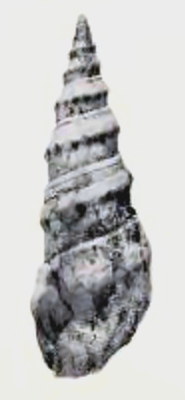Zemacies marginalis facts for kids
Quick facts for kids Zemacies marginalis |
|
|---|---|
 |
|
| An old picture of a Zemacies marginalis shell | |
| Scientific classification | |
| Synonyms | |
|
Zemacies marginalis was an ancient type of sea snail that is now extinct. It was a marine mollusk (a soft-bodied animal, often with a shell) belonging to the Borsoniidae family. This snail lived a very long time ago and is only known from its fossil shells.
What Did Zemacies marginalis Look Like?
Scientists have studied the shell of Zemacies marginalis from an imperfect fossil. This shell had seven main turns, called whorls, that made up its main spiral part, known as the spire. At the very top, there was a tiny, initial part of the shell called a protoconch, which had three small turns.
On the first six of these whorls, there were eighteen small bumps or "tubercles" along a ridge called the "keel." However, the very last and largest turn of the shell, known as the body whorl, was smooth. The lines where the different whorls joined together, called sutures, had a clear border in front of them.
The entire shell, including the small bumps, had many fine lines spiraling around it. These lines are called "spiral striations." By looking at the shell's growth lines, scientists could tell that the snail had a moderately sharp curve or "anal sinus" where its breathing tube (siphon) would have been. This curve was not as sharp as the one found in a related snail, Zemacies hamiltoni.
Zemacies marginalis was quite similar to Zemacies hamiltoni. However, it had a more noticeable border along its sutures. It also had more of the small bumps (tubercles) and many more spiral lines on its shell, both above and below the keel.
Where Did Zemacies marginalis Live?
This extinct marine snail was found only in New Zealand. Its fossils have been discovered in rock layers that date back to the Eocene period. Specifically, these fossils come from the Middle Eocene, which was about 47.8 to 37.8 million years ago. This means Zemacies marginalis lived in the oceans around what is now New Zealand during that ancient time.

